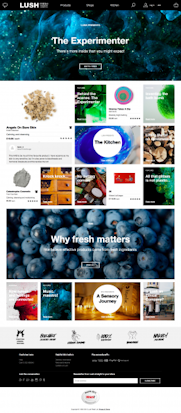

Acquia GmbH
Acquia ist die führende Digital Experience Company.Lush Brings Its Stories to Life Online, Integrating Content and Commerce
Dramatic Spike in Both Site Traffic and Online Business in First Six Months After Launch Leads to 64 Percent Increase in Digital Orders
For Lush, a UK-based company that makes natural, handmade cosmetics, a bar of soap isn’t just a bar of soap—it’s a story.
Each Lush product has a unique and important narrative that starts with the product’s invention and ingredient sourcing, and ends with the customer’s own experience. The company has been telling those stories in its stores for 20 years, inspiring a loyal fan following around the world.
The Challenge
With Lush’s in-store sales far outweighing those online, the Managing Director of Lush Digital, Jack Constantine, set out to bring the brick-and-mortar commerce experience to its UK website, powered by dynamic displays, interactive design, and an unforgettable look and feel.
Lush wanted to create a digital experience that would weave its stories throughout every page of its website and result in a spike in online sales. So, Lush Digital partnered with Method, an experience-design firm, and the Acquia Commerce Platform, which provided a strong framework for seamless integration of content and commerce.
The Solution
The brand/agency team brought each product story to life online by transforming Lush’s product pages into inspirational experiences, engaging users with photos, fun use scenarios, and breakdowns of ingredients. Lively, colourful video backdrops on every product page made the experience even more dynamic.
The idea of the new design is that content and commerce are strongest when woven together in a unified strategy. These inspirational pages are more than a place to engage users and inspire desire—they facilitate the purchase as well.
It was the Acquia Platform that gave Lush the flexibility to embed commerce into site content. The onsite experience—from the moment a user types in the URL for Lush’s website until long after they make a second, third, or hundredth purchase—was engineered to reflect the spirit of Lush’s brand.
The Lush Kitchen, an exciting and innovative feature on the site, is a clear example of how stories can be combined with web interactivity. Each day, cosmetics “chefs” whip up small batches of products and post them to an online menu. An interactive list of ingredients, and stories of how the products are individually sourced, accompanies each product page. If the demand for one of the batches is strong, the kitchen can quickly double or triple those products.
This turns a transactional commerce experience into a story-fuelled customer journey. It crowdsources a curated product set and allows the customer to influence product selection via instant feedback on products and ingredients. This is customer-driven commerce, where visitors influence product creation via their actions on the website. It’s taking the well known Lush store experience and bringing it online in a real and meaningful way.
The new site embraces a modern reality: 90 percent of users change devices in the midst of a shopping experience. A Lush shopper might search products via a mobile device on the train to work, use a traditional browser at the office, and finally make a purchase on a tablet back at home. These extended customer journeys take place on whatever device is most convenient at the time. It’s really shopping and browsing as a form of entertainment.
The team’s solution: a responsive design that delivers a seamless experience across various screen sizes, without losing the Lush storyline or the sense of fun that often inspires the whole multi-hop experience. This approach has paid off, with the influential Econsultancy blog naming Lush’s website
a leading example of responsive design.
To maintain and enhance the integration of content and commerce, customers get a personal dashboard, allowing them to add photographs, choose a favourite shop, and view each product ordered alongside product reviews and comments. The team also built a holiday wish list for users to save and share the items they want most. Subtle, personalised prompts follow shoppers throughout the site.
These content-driven commerce experiences were enabled by the Acquia Commerce Platform, which provided the reliable technology backbone that also ensured the site was secure and scalable. The Acquia Commerce Platform ensured that Lush’s site could handle a massive influx of traffic and transactions without compromising the integrity of the features and applications on the site.
The Results
What started as a single solution to enhance the customer experience in the UK turned into much more. Because of these tools, Lush’s Japan and Brazil sites were able to build their respective identities with a completely different team using the framework created by Lush UK, sticking to the core branding while making necessary regional changes.
This integration of content and commerce delivered amazing metrics to Lush UK: a dramatic spike in both site traffic and online business, providing an ROI in the first six months. It also lead to:
- 16 percent decline in abandoned carts
- 64 percent increase in digital orders
- 75 percent increase in website sessions
It not only helped build a larger, loyal community online, but it proved the power of commerce and content together.
Acquia Provides a Stable, Scalable Platform for RTL Nieuws
Dutch News Service, RTL Nieuws, Now Provides the Same Experience Across All Digital Channels
With millions of daily viewers and users, RTL Nieuws ranks among the top 20 most visited websites in the Netherlands. The company has several popular news brands, including RTL Nieuws, EditieNL, and RTL Z, with a total editorial staff of 165. Its goal is to provide its many visitors with independent, relevant national and international news via news bulletins on TV, its websites, and RTL Nieuws apps.
Traffic surges and peaks whenever there is breaking news, so a stable, scalable content management system (CMS) is essential to RTL Nieuws. Thanks to its collaboration with partner Acquia, and the web and mobile development firm Ibuildings, RTL Nieuws can now publish news items directly via several digital channels, easily and quickly.
The Challenge
The ability to process and publish breaking news quickly requires the digital platform to be efficient and user-friendly. In addition, RTL Nieuws wants to provide an optimal user experience for editorial staff and readers, enabling users to move quickly between news items via different digital channels.
To achieve this, RTL Nieuws went looking for a new content management system. Koen van Gestel, Project Manager Digital Media at RTL Nieuws, who is responsible for all digital technical projects, notes that the CMSs used previously were dated. What’s more, they were all tied to specific suppliers with different development cycles.
Van Gestel says, “We couldn’t keep up with technical developments, such as the implementation of responsive design, quickly enough. Also, RTL Nieuws was keen to move away from using a multitude of different systems. Bringing the news to the consumer through a variety of channels—television, the web, and our own app—made using these numerous systems too cumbersome and time-consuming for editorial staff. One of the biggest challenges was to improve the ease-of-use for editorial staff.”
The starting point was to provide the editorial staff with a central CMS that met the RTL Nieuws mission, namely delivering news on a fast, stable, and up-to-date platform.
Van Gestel says, “In our previous systems, the integration of external content was very laborious. The ability to provide such content properly is one of our spearheads. We spent a lot of time reproducing news items that had already been published via another RTL Nieuws channel. It was important to us to find a partner who was able to understand our needs and provide solutions tailored to the wishes of the organization and editorial staff.”
In 2012, RTL Nieuws opted to collaborate with Acquia Enterprise Partner Ibuildings, and implement Drupal, hosted on the Acquia Platform.
The Solution
Among other advantages, Ibuildings pointed out the benefits of open source to RTL Nieuws.
Martin Roest, architect at Ibuildings, says, “The use of an open source platform was new to RTL Nieuws. After a clear explanation about the benefits in terms of scalability, speed, stability, and the possibilities for its digital strategy, RTL Nieuws was convinced. We then started mapping the situation to subsequently translate it into an open source environment.”
Because of the urgency behind the implementation process, the first major advantage of open source—in this case, Drupal CMS—was apparent from the outset.
Van Gestel says, “By using open source and flexible partners, we were able to make adjustments quickly and easily, when necessary. The implementation of this project took only a few months. What’s more, connecting the current content systems—for instance, all video content—to Drupal turned out to be straightforward. Our expectations about the use of an open source platform have certainly been met.”
The Results
The knowledge and expertise of Ibuildings and Acquia, combined with the stable, scalable hosting services of Acquia, have resulted in an innovative, up-to-date CMS that enables RTL Nieuws to provide consistent digital experiences to its visitors. RTL Nieuws has already seen many benefits, among other things on the side of editorial staff. Van Gestel says, “If we just consider the amount of content—about 300 news publications a day—having a stable platform is important. RTL Nieuws aims to be the first to deliver news, so a good CMS is essential. Ibuildings and Acquia give us this security and have proven themselves doing so.”
“Before [implementation], consumers clearly preferred television and a browser. Now, there is a very emphatic rise of mobile channels. The new digital strategy allows us to create the same experience across all channels. Partly because of this, there has been an exponential growth in the use of RTL Nieuws via the apps, which is now 50 percent of the total number of visits,” according to van Gestel.
RTL Nieuws wants to continue to innovate. With open source, the organization can use innovations introduced from the Drupal community and made instantly available. That way, RTL Nieuws continuously benefits from new developments. Roest says, “For us as a partner, the challenge is to keep advising RTL Nieuws about new developments—for instance, the personalization of news content beyond the headlines—which provides the reader with customized news. That’s the great thing about Drupal; there is always room to more fully develop a basic implementation in accordance with the wishes of the customer.”
The success of Acquia as a hosting platform is clear from the recent renewal of the contract. Van Gestel says, “In September 2014, we extended the contract with Acquia for another three years. Thanks to a pleasant collaboration, their in-depth knowledge, and excellent results, we have opted to stick with an open source solution.”
Acquia Helping Hubert Burda Media Turn Anonymous Users into Known Customers
Das Verlagswesen braucht neben den Vertriebserlösen und dem Anzeigengeschäft eine dritte Umsatzquelle – die kann nur von Kunden kommen. Wer sind die Kunden? Welche Vorlieben haben sie? Was lesen sie? Wofür geben sie Geld aus? Darüber haben die Verlage bislang nur sehr wenige Informationen. Der Burda-Verlag wollte es genau wissen und die Leser des Fashion-Magazins InStyle und deren Vorlieben besser kennenlernen. Burda nutzt daher seit Kurzem eine leistungsfähige Kombination aus dem Open-Source-Content-Management- System (CMS) Drupal und der Personalisierungslösung Acquia Lift.
Damit schafft Burda die Basis dafür, dass aus anonymen Besuchern der Website von InStyle später Kunden werden. Burda hat die Leser und jetzt auch die passenden Tools zur Hand. Drupal und Acquia unterstützt Burda dabei, dass aus 52 Millionen anonymen Lesern eine Zielgruppe von vertrieblich ansprechbaren Kunden zu machen. Burdas größte Herausforderung bestand darin, die Produktmanager und Redakteure dazu zu bringen, dass sie aus Sicht der Kunden denken, anstatt den Weg über die Inhalte zu gehen.
Bislang wurden die Produktmanager an den Anzeigenumsätzen gemessen. Die wichtigsten Performanceindikatoren waren Page Impressions und Unique Visitors. Die Aufgabe der Produktmanager bestand unter anderem darin, die Google-Analytics-Zahlen mit Hilfe des publizierten Contents zu optimieren. „Vor dem Hintergrund sinkender Anzeigenumsätze galt es neue Wege zu beschreiten, um eine dritte Umsatzquelle bei Kunden zu erschließen“, berichtet Burda. „Wenn wir wissen, wer unsere Kunden sind, was sie mögen und was sie kaufen, verfügen wir über das notwendige Wissen, was wir ihnen anbieten können, um die Kundenbeziehungen umsatzmäßig erschließen zu können.“ In diesem Zusammenhang entstand auch ein neues Set von KPIs. Dazu gehört beispielsweise die Zahl der bekannten Kunden und die Konversionsrate der Anzahl anonymer Besucher gemessen an den bekannten Kunden.
Website-Besucher mit Drupal und Acquia Lift einbeziehen
Burda nutzt das Open-Source CMS Thunder auf Basis von Drupal zusammen mit Acquia Lift plus einige weitere Technologien für den Aufbau von Beziehungen zu Website-Besuchern. Im ersten Schritt geht es darum, die unbekannten Website-Besucher besser kennenzulernen und im zweiten Schritt um die Bereitstellung personalisierter Inhalte.
Auf der Website von InStyle analysiert Burda auf Basis von Browser-Cookies Informationen zu den anonymen Besuchern: Wo kommen sie her? Wie sind sie zur Website gekommen? Welche Medien lesen sie? Haben sie die Website früher schon einmal besucht?
Segmentierung der Website-Besucher und einfache Personalisierung
Als Ergebnis entstehen fundierte Vermutungen darüber, was die Besucher interessieren könnte. Wer zuvor bereits beispielsweise nach den Themen Gesundheit und Ernährung suchte, wird in das Segment Food & Fitness eingeordnet. Rufen diese Besucher das nächste Mal die InStyle-Website auf, sehen sie eine personalisierte Seite mit Inhalten, die ihren Interessen entsprechen.
Darüber hinaus arbeiten die Burda-Experten daran, auch die Interessen von Besuchern zu berücksichtigen, die von anderen Websites kommen. Wer beispielsweise über Google Search zur InStyle-Website gelangt, sieht einen anderen Content als Besucher, die von Facebook kommen – auch, wenn der semantische Inhalt der Herkunft ähnlich ist.
Burda spricht Besucher der InStyle-Website direkt an und bittet sie, ihre E-Mail Adresse zu hinterlassen – nach dem Motto „Tausche E-Mail-Adresse gegen coole Trends“. Viele sind dazu bereit, da sie dann Zugang zu Newslettern, Online-Quizspielen, Preisausschreiben und attraktiven E-Commerce-Angeboten erhalten.
Ist die Anonymitätsschranke einmal überwunden, kann Burda den Dialog mit Website-Besuchern starten und sie in Kunden und Verbraucher verwandeln, die mehr tun, als nur Anzeigen anschauen. Zusätzlich zu den grundlegenden Informationen auf Basis von Google Analytics erfährt Burda mehr über sie: ihre Interessen bezügliche bestimmter Newsletter, Öffnungs- und Klickraten sowie Lese- und Kaufhistorie.
Im Laufe der Zeit lernt Burda mehr über das Verhalten der bekannten Website-Besucher und stellt ihnen auf ihre Bedürfnisse hin abgestimmten Content bereit. Dies ist erst der Anfang. Burda kann auf die Kunden eingehen, den Kontakt mit ihnen pflegen, neue Ideen für Upselling oder auch ganz neue Produkte mit einer bekannten Zielgruppe testen. Die dritte Umsatzquelle wird Realität, wenn Burda über seine digitalen Kanäle Produkte verkauft, die Kunden auch wirklich interessieren.
Das für die dritte Umsatzquelle verantwortliche Team bereitet für die Geschäftsleitung und die leitende Mitarbeiter BI-Reports auf, die den Kunden- und Nutzungskontext verdeutlichen. Mit diesen Daten lassen sich bestimmte Annahmen über das Nutzerverhalten überprüfen und neue Metriken und Methoden entwickeln. Aufgrund der Analysen ist es auch möglich, neue Kundensegmente einzurichten, bei denen sich ein deutlicher Zusammenhang zwischen den Interessen für mehrere Themenbereiche zeigen, nach dem Motto Kunden, die Produkt A kauften, interessieren sich für Produkt B. „Durch den Einsatz von Acquia Lift verfügen wir über einen Rückkanal zu den Usern. Wir nutzen diese Beziehungen für den Aufbau genauerer Profile“, berichtet Burda. „Damit sind wir in der Lage, den bekannten Kunden maßgeschneiderte Inhalte, Produkte und Empfehlungen anbieten zu können, die uns dabei helfen, unsere Geschäftsziele zu erreichen.“
Daten & Kontakt:
+49-89-5506280
Mitarbeiterzahl: >500

